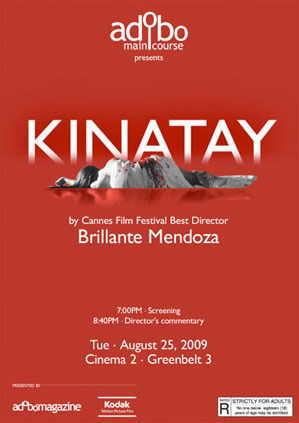
KINATAY
Philippines, 2009, 110 minutes, Colour.
Coco Martin, Julia Diaz, Maria Isabel Lopes, Mercedes Cabral.
Directed by Brillante Mendoza.
Kinatay is a Filipino word for slaughter. And that is what happens in the third act of this film, a barbaric torturing and dismembering of an addicted prostitute.
However, the film begins in a bright and breezy way as Peping (Brillante regular, Coco Martin) goes to his wedding ceremony with his bride and extended family while the grandmother looks after the baby. This provides a first act with lots of local colour and street photography that immerses us in daylight Manila. The ceremony is cheerful. The dinner afterwards a happy occasion.
The second act, after we see Peping in the police academy is one of the most tedious van journeys we are likely to experience. We go across Manila in the dark with the crew and the abducted woman. Hard to see, repetitious and long, a point being that it takes quite some time to cross the city.
Then the third act with the brutal slaughter.
Brillante Mendoza has been documenting the underside of Filipino life in Masahista, Tirador, Foster Child, Serbis. This film is only a mixed blessing -with some ugly downside.
1.The work of Brillante Mendoza? Guerrilla film-making? Slices of Filipino life? The ugly side?
2.The title, the literal meaning of slaughter? The third act and its presentation of barbaric slaughter?
3.The life in the Philippines: the first act, Pepping and Cecile hurrying to the wedding, the baby, to the grandmother? In the taxi, in the Jeepnay? Delight, playful, the rings, money and loans? The overview of Manila itself, the streets, traffic, the shops and stalls, the people? The delay with the man wanting to throw himself from the building, the media, the interviews with the mother, her pleading? The police? The wedding itself, the judge, cheerful, everybody happy, the ceremony? The dinner, Leo and his hosting, the godfather? The allusions to his way of life? The photos, the food? Pepping and his taking the money? His going to the police academy, his not paying attention? The instructor and the development of the theme of investigating a crime scene?
4.Investigation of the crime scene: from the outside, going in? Mendoza using this method for the crime of the slaughter, looking at the people and the situation from the outside? Going in?
5.The long ride through Manila, the dark, real time, audiences identifying with Pepping and his tension? Or not? The city at night? The religious signs? The sergeant, the chief, the young men? Pepping and his being a bagman contact for deals? His being invited into this crime? Once into the van, giving his consent?
6.The nightclub, the strippers, the customers? Madonna, the money loans, her child, her aunt and the preparation for the party? Her being abducted, humiliated in the van?
7.Going to the house, buying the duck eggs, Pepping and the opportunity to leave, buying the eggs, going into the bus, coming out again? His going back – and the caption about integrity and it being lost forever?
8.The brutal interrogation of Madonna, the chief, sergeant? The sexual abuse? Her murder, dismemberment? Pepping and his witnessing this? Guarding her? His decision to enter into the cleanup?
9.The disposal of the parts around the city? The media and the people discovering the body parts? The news item about the gang in the city, the police unable to identify them? The irony that it was the police themselves?
10.The overall view of Mendoza on these situations, these people? A pessimistic viewpoint?